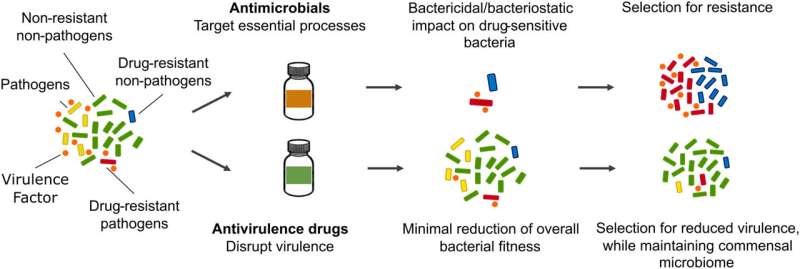This article has been reviewed according to Science X's editorial process and policies. Editors have highlighted the following attributes while ensuring the content's credibility:
fact-checked
peer-reviewed publication
trusted source
proofread
New research aids fight against treatment-resistant superbugs

Researchers at Simon Fraser University are studying the genes of superbugs to aid the development of new and effective treatments for drug-resistant bacterial infections. Superbugs are characterized as infection-causing bacteria resistant to treatment with antibiotics.
"Antimicrobial resistance occurs when the disease-causing bacteria has ways to overcome the antibiotics that we use in treatment for infections," says assistant professor Amy Lee, of SFU's Department of Molecular Biology and Biochemistry. The initiative is a collaboration between the Lee Lab and Brinkman Lab, which are working together as part of the interdisciplinary SFU Omics Data Science Initiative (OSDI). "Our lab tries to understand how bacteria develop resistance because that makes the drug ineffective," says Lee.
Their review of work to identify pathogen-associated genes in various disease-causing bacteria and develop new antivirulence drug treatments has been published in eBioMedicine.
Antibiotic or antimicrobial resistance has been named a top global health threat by the World Health Organization (WHO).
"The ultimate goal of our research is to use current sequencing technologies and computational analysis to discover new drug targets, which can be used to develop new drugs to fight bacterial infections," says SFU alumnus Venus Lau, the study's lead author.
The team applied bioinformatics, using SFU's Big Data Hub, to perform a computational analysis of thousands of bacterial genomes from Escherichia coli to Vibrio cholerae.
"The one bacteria species I was most interested in was Pseudomonas aeruginosa," says Lau. "It is known to be naturally resistant to drugs based on their cell membranes."
"Drugs don't get into this bacterium easily and they tend to acquire other resistance mechanisms over time. It's a difficult bug to treat."
The bacterial species P. aeruginosa can cause infections in the blood, lungs (pneumonia) or other parts of the body, particularly in those who are ill or recovering from surgery in hospital.
Lau notes that some of the genes the team discovered through analyzing various disease-causing bacteria had not been previously characterized. "Part of our research was to figure out what these genes do and how they're responsible for causing disease and infection symptoms in humans."
Antivirulence over antibiotics to treat bacterial infections
An alternative approach to treating bacterial infections with antibiotics to overcome the issue of drug resistance involves antivirulence drugs.
New antivirulence therapies work to 'disarm' or inhibit the ability of the bacteria to cause disease without causing resistance to develop. In contrast, antibiotics kill bacteria, which essentially encourages the bacteria to 'fight back' by developing drug resistance.
"Antibiotics wipe out bacteria leading to a process of natural selection where those few surviving bacteria in the population will then repopulate," says SFU molecular biology and biochemistry postdoctoral fellow Patrick Taylor. "The bacteria that are not killed off are really good at sharing their genetics with each other, which is why we have this rising global issue of antibiotic resistance."
Antibiotics also eliminate non-disease-causing gut microbiota, or the 'good bacteria' that exists in the human body, which can have additional negative health impacts.
Taylor says antivirulence therapeutics can mitigate disease and reduce the burden on the healthcare system by reducing the bacteria's ability to cause damage to the host, which provides time for the person's immune system to clear the pathogen.
Continued work towards developing antivirulence drugs is needed as the WHO estimates that antimicrobial-related infections currently account for over 700,000 annual deaths and are projected to reach 10 million annual deaths by 2050.
More information: Wing Yin Venus Lau et al, Pathogen-associated gene discovery workflows for novel antivirulence therapeutic development, eBioMedicine (2023). DOI: 10.1016/j.ebiom.2022.104429
Journal information: EBioMedicine
Provided by Simon Fraser University




















